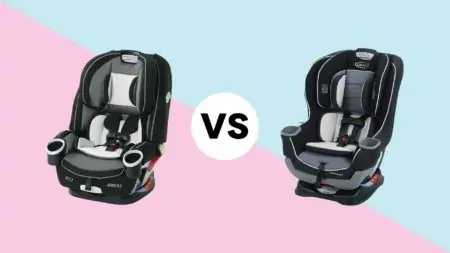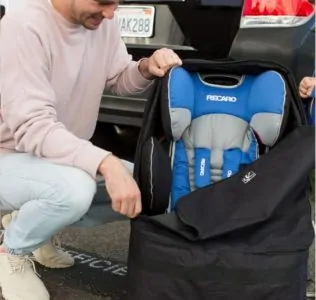Is your little one suddenly looking giant in their car seat? It happens fast. One day they fit perfectly; the next, their head is popping over the top. It is likely time to start looking for an upgrade.
Growth spurts aren’t the only reason to make a switch, though. You also need to shop for a new seat if yours expires or is in your vehicle during an accident.
As a passenger safety technician, I am happy to share the rules of the road. Let’s break down exactly when it is time to swap that seat out so your child stays safe and secure.
Key Takeaways
- Check the limits: Verify height and weight restrictions in your manual; rely on the stricter limit rather than just age.
- Know the stages: Understand the progression from infant seats to convertible, forward-facing, and finally, booster seats.
- Watch the expiration: Car seats have shelf lives; replace them immediately if they pass their expiration date or endure a moderate-to-severe crash.
- Recycle right: Don’t just toss old seats; use trade-in events or follow local recycling guidelines to dispose of them safely.
Outgrowing Restrictions
You are likely here because your child never seems to stop growing. This is a good thing! However, it comes as a surprise when you realize they no longer fit in their current gear.
A properly fitting car seat is more comfortable for your child and keeps them significantly safer. Laws also require children to use age-specific seating.
State laws vary, but they are generally the bare minimum. Best practice usually involves keeping children in more protective stages longer than the law requires.
For example, many states allow booster use at age 4. However, most 4-year-olds lack the skeletal development and maturity to sit properly in a booster.
It’s important to remember that state laws are usually the bare minimum standard for car seat safety. Many laws are outdated. The best practice is to max out the height and weight limits of your car seat before moving to the next stage.
Editor's Note:
Kristen Gardiner, CPSTSo when do you switch your child due to height or weight limits? It varies by seat.
Many manufacturers design seats to last longer. You can find convertible seats or all-in-one options that transform from infant seat to booster. Always keep your child’s age, height, and weight handy when choosing the next step.
Infant Seat Restrictions
Most infant seats accommodate children up to 22 to 35 pounds (1). This might make it seem like the seat will last for years. However, height often dictates the switch before weight does.
There isn’t one universal height limit. It depends on the shell height of your specific carrier.
The 1-Inch Rule: A clear sign you need to switch is when there is less than one inch of space between the top of your child’s head and the top of the car seat shell. Check your manual for specifics.
Safe Kids Worldwide recommends children ride rear-facing as long as possible (2). If your child outgrows the infant carrier before age two, you need a convertible seat installed in the rear-facing position. Do not switch them to forward-facing just yet.
Convertible Seat Restrictions
Convertible car seats are the workhorses of passenger safety. While many accommodate up to 65 pounds, some “all-in-one” models go even higher (3).
Some all-in-one seats can be used until your child reaches 120+ pounds.
Convertible seats last much longer than infant seats because they have taller shells.
Each mode (rear-facing, forward-facing, and booster) has its own distinct limits. When a child exceeds the height *or* weight limit for rear-facing, they have outgrown that mode. You can then switch the seat to forward-facing.
Read your manual carefully. It will list other criteria for outgrowing the seat, such as harness strap placement relative to the shoulders.
Sometimes the allowed ranges for rear-facing and forward-facing overlap. In these cases, experts recommend keeping your child in the safer, rear-facing phase until they max out the limits.
Forward-Facing Car Seat Restrictions
Once your child maximizes the rear-facing limits, they are ready to face forward. Your manual will list the new maximum height and weight.
You must also watch the harness fit.
Harness Rules:
- Rear-Facing: Straps must be at or below the shoulders.
- Forward-Facing: Straps must be at or above the shoulders.
When the straps are in the highest slot but fall below your child’s shoulders, they have outgrown the harness mode. It is time for a booster.
Additionally, ensure the tops of their ears are below the top of the headrest.
The National Highway Traffic Safety Administration (NHTSA) recommends children use a five-point harness until they are at least 5 to 7 years old.
A five-point harness spreads crash forces over the strongest parts of the body. It also forces the child to sit correctly. In a booster seat, a wiggly child might slump into an unsafe position.
Booster Seat Restrictions
Booster seats generally start at 40 pounds. You will find backless versions and high-back versions. High-back boosters offer better side-impact protection and support for kids who fall asleep in the car.
Many boosters accommodate children upwards of 100 pounds. The primary goal of a booster is to position the adult seatbelt correctly across a smaller body.
Proper Fit Check:
- The shoulder belt should lie firmly across the middle of the shoulder/chest, not the neck.
- The lap belt should sit low on the upper thighs, not the stomach (4).
- The belt must not be twisted.
Most children need a booster until they are 10 to 12 years old to pass the “5-Step Test” for using a standard seat belt alone.
Expired Car Seats
Did you know car seats have an expiration date? It is usually stamped on the plastic shell or the manufacturer label. If that date has passed, you need a new seat immediately.
Car seats expire for several critical reasons (5):
- Materials degrade: Plastic gets brittle over time. Extreme heat and cold in your car cause the materials to expand and contract, weakening the frame.
- Wear and tear: Daily use takes a toll. Food crumbs, spills, and constant adjusting degrade the mechanisms. Cleaning chemicals can also weaken the harness webbing over time.
- Technology improves: Safety standards evolve constantly. Newer seats have better side-impact protection and updated installation systems that older seats lack.
Car Accidents
You must also consider switching seats after a crash. If you are involved in a moderate or severe accident, the seat must be replaced immediately (6). Crash forces can stress the plastic invisibly, making it unsafe for a second impact.
However, the NHTSA states you *might* not need to replace seats after a “minor” crash. An accident is only considered minor if ALL of the following are true:
- The vehicle could be driven away from the crash site.
- The door nearest the car seat was not damaged.
- No passengers sustained any injuries.
- Airbags did not deploy.
- There is no visible damage to the car seat.
If your accident fails even one of these points, replace the seat.
Important: Some manufacturers require replacement after *any* crash, regardless of severity. Always check your specific manual. When in doubt, call the manufacturer or a local CPST (Child Passenger Safety Technician).
How to Properly Dispose of the Old Car Seat
So what do you do with the old car seat? Do not just put it on the curb; someone might pick it up and use an unsafe seat.
Stores like Target offer “trade-in” events annually. You bring in your old seat (expired or damaged) and receive a coupon for new baby gear.
If you don’t use a trade-in event, you can recycle or dispose of it yourself. Follow these steps to ensure nobody reuses it:
- Find a recycler: Check if your local waste management center accepts car seats. You can look for locations here.
- Strip the seat: Remove the fabric cover and foam padding. Throw these in the trash.
- Cut the straps: This is the most important step. Cut the harness straps effectively so the seat cannot be used again.
- Mark the shell: Use a permanent marker to write “UNSAFE,” “DO NOT USE,” or “EXPIRED” directly on the plastic shell.
- Separate materials: If required by your recycling center, use a screwdriver to separate metal parts from the plastic base.
FAQs
In Conclusion
Switching car seats feels like a milestone and a math problem all in one. Trust the manual, measure often, and prioritize the tightest fit over the trendiest brand.Keep those expiration dates in mind and do not rush to the next stage. Keeping your child in each stage for as long as possible is the safest way to travel. You’ve got this!











